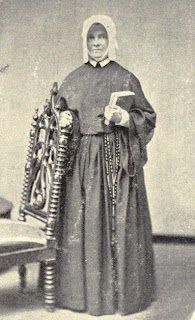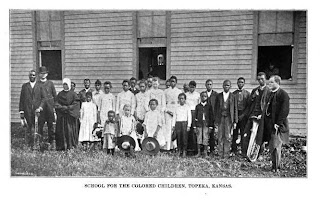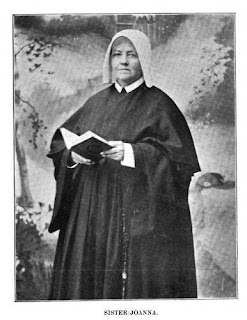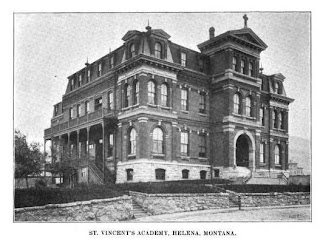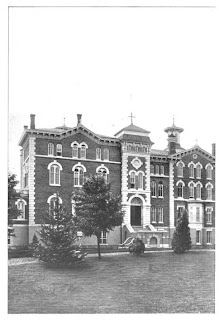As the Civil War approached, 1850’s Kansas was center-stage for the brewing conflict. Pro-slavery and anti-slavery factions battled it out for control of the state with knives, guns, even with cannons. Located on the banks of the Missouri River, Leavenworth was a bustling city where, one historian writes, “robberies, stabbings, lynchings, hangings, tarrings and featherings were not at all uncommon.” In short, it was a pretty rough place.
Not much surprised its citizens, a hardened lot. But on the morning of November 11, 1858, they witnessed a unique sight that did. A small group of women all dressed alike in long black robes and bonnets, stepped off a boat at the landing. They were the first Catholic nuns most of them had ever seen. The Sisters of Charity had come to “Bleeding Kansas.”
They arrived with almost nothing. But in time they created a network of schools, hospitals, and orphanages stretching across the West from New Mexico to Montana. Their leader, Mother Xavier Ross (1813-1895), was a small woman, barely five feet tall and hard of hearing. But she was a formidable character who, a contemporary wrote, possessed “the will of a winner.”
Born Ann Ross in Cincinnati, her father was a Methodist preacher who doted on her. But he was highly displeased with his teenage daughter when she showed an interest in the institution he despised most. It started after she visited a local Catholic church with a friend. After reading everything she could find on the subject, she told her father she wanted to convert, “to do something for God and souls.” Her father answered, “What can a woman do?”
Nevertheless, she became a Catholic, and when she was nineteen, she joined the Sisters of Charity of Nazareth, a religious community based in Kentucky. Newcomers received a new name that denoted the change in their lives. Ann was renamed Xavier, for the sixteenth-century Jesuit missionary. Her father never forgave her. He sent her a lock of his now-gray hair with the note, “You have done this.”
As she taught school in Kentucky, her leadership skills emerged. In 1851, when the Bishop of Nashville asked for Sisters, she was sent there as mother superior. The Sisters didn’t know that the priest assigned to help them used his parishioners’ money to purchase their buildings. When he left unexpectedly, people demanded their money back. The bishop refused to honor the debt, forcing the Sisters to sell nearly everything they had.
By then, Mother Ross had her fill of Nashville. A priest friend suggested contacting Bishop John B. Miège, whose cathedral was a small wood-frame building in Leavenworth. He invited them to come, and thus began the Sisters of Charity of Leavenworth. Mother Ross admitted that their original housing was “perhaps not exactly gorgeous.” Soon after their arrival, they started teaching. In March 1859, they opened St. Mary’s Academy on Kickapoo Street (now the University of St. Mary). Soon a novitiate (where new Sisters, called novices, were trained) opened. Novices literally drew their religious names from a hat.
Within a few years they opened orphanages and hospitals. In 1864, they opened St. John’s, Kansas’ first private hospital. In Topeka, they opened an orphanage for African-American children. Mother Ross frequently reminded her Sisters, “Always be good to the orphans!” (The nuns recalled that she never spoke to them “in a tone of command.”)
She mixed a sharp business sense with a strong faith. One of her favorite maxims was “Trust in God, and beg for funds.” On one occasion, she had the Sisters pray non-stop vigils in the chapel while she negotiated a bank loan. They traveled widely on fundraising trips. Once they approached a lawyer who wrote them a large check because, he said, nuns had looked after him when he was “a penniless boy,” with “as much care as if I were a millionaire.”
In time the Sisters received requests from throughout the West. They traveled by stagecoach through Indian territory, sometimes at risk to their lives. The schools and hospitals they founded in Montana and Wyoming, the orphanages in Colorado, and a sanitarium in New Mexico were among the very first the people in those areas ever saw. Mother Ross encouraged initiative: “If you see anything that needs to be done, do it! Don’t wait to be asked or told.”
Wherever they went, they made a difference. A dying African-American woman, rescued from a brutal winter, told one Sister, “If you ain’t saved, I don’t know who is!” A young Protestant man in one of their hospitals was asked if he wanted a minister. “No,” he said, “Sister Mary Lawrence can pray over me just as good.” A prisoner about to be hung for murder promised to good for them in heaven, since he couldn’t repay them on earth.
Mother Ross traveled widely, but she especially loved the Kansas plains. In later years she gave retreats that mixed traditional Catholic wisdom with American practicality. She told retreatants, for example, “Always remember that every day is a new year. We needn’t wait for the first of January.” On April 2, 1895, after sixty-three years a nun, Mother Ross died at the motherhouse she had built. By then, her community had over three hundred Sisters.
Women religious are Catholic America’s unsung heroes. Mother Ross is but one example. Many were the first female college presidents, hospital administrators and social workers. Catholics and non-Catholics alike admired their determination, ability and compassion. One western newspaper said of a group of nuns who nursed the sick during a local epidemic: “The idea of danger never seems to have occurred to these noble women; self was lost sight of.”
“What can a woman do?”

